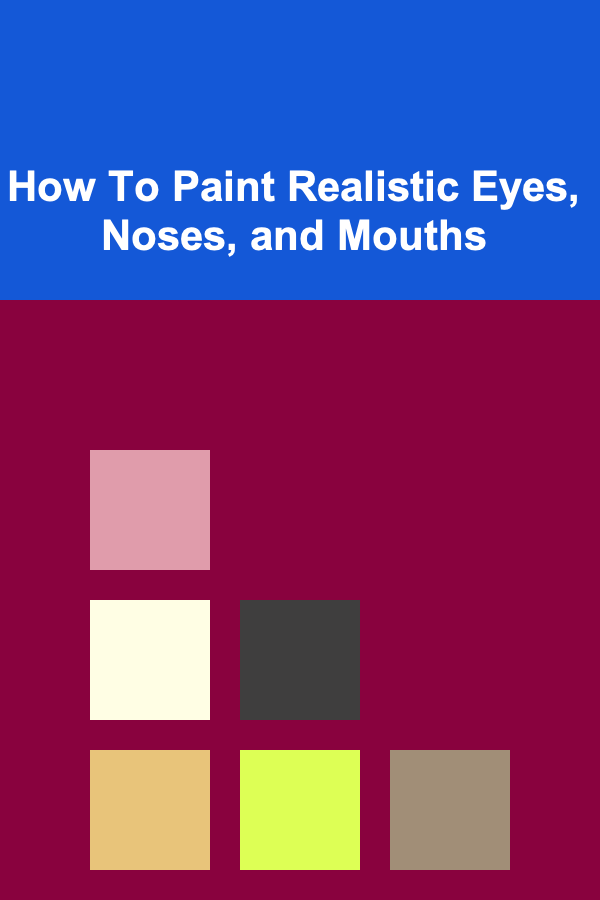
How To Paint Realistic Eyes, Noses, and Mouths
ebook include PDF & Audio bundle (Micro Guide)
$12.99$8.99
Limited Time Offer! Order within the next:

Painting realistic features such as eyes, noses, and mouths is a challenging yet highly rewarding endeavor for artists. These features play a pivotal role in capturing human expression and character. Mastering the art of painting these features requires a blend of technique, observation, and understanding of anatomy. This article will delve into the step-by-step process of painting realistic eyes, noses, and mouths, and will discuss the key concepts and techniques necessary to elevate your portraiture skills.
Understanding Anatomy and Structure
Before diving into the painting process, it is crucial to understand the anatomy of the eyes, nose, and mouth. A strong grasp of anatomy helps in capturing realistic proportions and creating depth. These features may seem simple at first glance, but their underlying structures are complex and can vary significantly from person to person.
The Eye
The eye is often referred to as the "window to the soul," and it certainly plays a central role in portraiture. The eye consists of several parts, including the sclera (white part), iris, pupil, eyelashes, eyelids, and tear ducts. Understanding how light interacts with these elements can help in creating a realistic depiction.
Key Points for Painting Eyes:
- Proportions: The average eye is about 1/5th of the width of the face, and it sits approximately halfway between the top of the head and the chin.
- Sclera: The sclera is not purely white; it has subtle variations in tone, often with shadows due to the surrounding eyelids.
- Iris and Pupil: The iris has a rich texture with visible patterns and color variations. The pupil appears black but is not a solid color; light can cause reflections and distortions within it.
- Eyelids and Eyelashes: These help frame the eye and contribute to its overall shape. The eyelids often cast a shadow across the sclera, creating depth.
The Nose
The nose is another essential facial feature, and its structure is defined by the bone and cartilage that form the bridge and nostrils. While the nose appears relatively simple, the subtleties of light and shadow give it depth and dimension.
Key Points for Painting Noses:
- Nasal Bridge: The nose bridge starts at the brow and slopes downward. The area between the eyes often casts a shadow across the upper portion of the nose.
- Nostrils: Nostrils are typically asymmetrical, and the shape of each nostril varies from person to person.
- Nasal Tip: The tip of the nose may catch highlights, especially if the subject is illuminated from the front. It is essential to observe how the tip forms curves that react to light.
The Mouth
The mouth is not just about the lips; it is a complex structure that plays a significant role in facial expression. The corners of the mouth, the upper lip, and the lower lip all contribute to a person's unique look.
Key Points for Painting Mouths:
- Lip Shape: The upper lip often has a defined "Cupid's bow," while the lower lip is fuller and more rounded.
- Shadows and Highlights: The lips are fleshy and soft, making them an excellent area for playing with shadows and highlights. The lower lip, for example, often catches more light than the upper lip.
- Smile and Expression: The way the mouth curves affects the overall facial expression, whether it's a subtle smile or a wide grin.
Preparing Your Workspace and Materials
Before starting, ensure that your workspace is set up with all the necessary materials. Realistic portraiture demands attention to detail, so your tools should be of the highest quality to achieve the desired effect. Here are the basic materials needed for painting realistic eyes, noses, and mouths:
- Canvas or Paper: Choose a smooth, high-quality canvas or watercolor paper to allow for intricate detail.
- Paint: Whether you're working with oils, acrylics, or watercolors, select the right paint for the style you wish to achieve. Oils are commonly used for realism due to their blendability, while acrylics offer quicker drying times.
- Brushes: Use a variety of brushes, including small round brushes for fine details and larger flat brushes for broad strokes and blending.
- Palette and Mediums: A well-organized palette with various shades of skin tones, whites, blacks, and browns is essential. You may also want to use blending mediums, such as linseed oil for oils or water for watercolors.
- References: High-quality reference images or live models are crucial for painting realistic facial features. Pay close attention to lighting, angles, and the proportions of the face.
Step-by-Step Guide: How to Paint Realistic Eyes
Painting eyes requires precision, patience, and an eye for detail. The following step-by-step guide will walk you through the process of painting realistic eyes:
Step 1: Sketch the Outline of the Eye
Start by sketching a basic outline of the eye on your canvas or paper. Remember that the shape of the eye is generally almond-shaped, but this can vary based on the person. Outline the eyelids, iris, and pupil.
Step 2: Define the Iris and Pupil
The iris is the colored part of the eye. Carefully paint the iris, starting with the base color and gradually adding darker tones around the edges. Remember, the iris is not a flat circle---it has depth, and you can create this illusion by adding subtle gradients. The pupil should be painted black and can have subtle reflections of light, so make sure to leave small white spots where light may hit.
Step 3: Add the Sclera and Details
The sclera, or white part of the eye, is rarely pure white. Observe the color variations and light reflections on the sclera. Use a slightly off-white color for the sclera, adding small shadows and veins for realism. The veins should be thin and delicate; they can be added with a fine brush using red or blue tones.
Step 4: Paint the Eyelids and Eyelashes
Next, focus on the eyelids and lashes. The upper eyelid typically casts a shadow across the sclera, so paint this area with a slightly darker tone to suggest depth. Add eyelashes with a fine, sharp brush, following the natural direction of the lashes. Eyelashes should be placed sparingly to avoid over-cluttering the eye.
Step 5: Add Highlights and Reflections
The final touch for the eye involves adding highlights and reflections. Light reflects off the moist surface of the cornea, creating small white spots or streaks of light. These highlights are essential for giving the eye a lifelike shine. Use a tiny brush to add these highlights, ensuring they're subtle yet noticeable.
Step 6: Blend and Refine
After painting the individual elements, step back and assess your work. Blend the edges where necessary, especially around the iris and sclera, to create smooth transitions. Continue refining the shadows, highlights, and details until the eye looks three-dimensional and realistic.
Step-by-Step Guide: How to Paint Realistic Noses
The nose is often considered one of the more challenging features to paint. However, by understanding its structure and using proper techniques, you can achieve a realistic result.
Step 1: Sketch the Basic Shape of the Nose
Begin by sketching the basic shape of the nose, including the nostrils and the bridge. Pay attention to the proportions and angles. Ensure that the nose is correctly aligned with the rest of the face, considering the relationship between the eyes and the mouth.
Step 2: Paint the Bridge and Tip
The bridge of the nose typically has a light shadow cast by the brow. Use a soft, gradual transition between light and shadow to create the illusion of a rounded structure. The tip of the nose should have more pronounced highlights, especially if the light source is coming from the front.
Step 3: Add Depth to the Nostrils
Nostrils can be tricky, as they have depth and their shapes are often asymmetrical. Observe the subtle shadows around the nostrils and paint them accordingly. Darken the inner nostrils and blend the shadows into the surrounding skin tones.
Step 4: Refine and Blend
Once the initial layers of paint are dry, go back and refine the shapes. Use blending techniques to smooth out any harsh lines and create a seamless transition between shadows and highlights. Pay attention to the edges of the nose where it meets the cheeks and forehead.
Step 5: Final Highlights and Details
Add final highlights to the nose, especially on the tip and along the bridge. These highlights should be subtle, but they will help bring out the three-dimensionality of the nose. Keep the skin tones consistent, and add small veins or pores if necessary for added realism.
Step-by-Step Guide: How to Paint Realistic Mouths
The mouth is another feature that demands attention to detail. A realistic mouth can convey a range of emotions, from a subtle smile to an intense expression.
Step 1: Sketch the Shape of the Lips
Start by sketching the basic shape of the lips, paying close attention to the proportions. The upper lip typically has a "Cupid's bow," while the lower lip is fuller and rounder. Ensure the shape of the lips is in alignment with the rest of the face.
Step 2: Add Base Color to the Lips
Paint the base color of the lips, using a variety of tones to reflect the natural color of the lips. The upper lip is generally darker than the lower lip, and you should paint the color in layers for a more natural look. Use light pinks, reds, or browns depending on the skin tone.
Step 3: Add Shadows and Highlights
Shadows play a significant role in creating depth in the mouth. Add shadows along the edges of the lips, particularly where the upper lip meets the skin. Highlight the center of the lower lip to make it appear plumper and more three-dimensional. Use subtle shading to define the creases and folds of the lips.
Step 4: Define the Corners of the Mouth
The corners of the mouth often contain subtle shadows that help anchor the lips to the face. Add depth by darkening the corners of the mouth and blending the shadows into the surrounding areas.
Step 5: Final Refinements
Once the lips are painted, refine the details by adding texture to the skin around the lips. You can add tiny creases or fine lines to suggest the natural texture of the lips. Pay attention to the overall composition and ensure the mouth integrates smoothly with the rest of the facial features.
Conclusion
Painting realistic eyes, noses, and mouths is a skill that requires patience, practice, and a keen understanding of human anatomy. By following the step-by-step processes outlined in this guide and continually observing your subject, you can achieve lifelike results that bring your portraits to life. Remember that the key to mastering realistic portraiture lies in subtlety---small details, such as the light reflection in the eye or the shadow under the nostrils, can make a significant difference. Keep practicing, and your ability to paint these essential features will improve with time and experience.
Reading More From Our Other Websites
- [Home Cleaning 101] How to Clean Your Home in 15 Minutes a Day
- [Organization Tip 101] How to Label Pantry Items for Quick Identification
- [Personal Investment 101] How to Invest in Gold ETFs: A Beginner's Guide to Diversifying Your Portfolio
- [Home Pet Care 101] How to Manage Your Pet's Arthritis or Joint Pain at Home
- [Home Maintenance 101] How to Insulate Your House for Better Energy Efficiency and Comfort
- [Gardening 101] Essential Principles of Garden Design for Beginners
- [Home Budget Decorating 101] How to Achieve Affordable Home Decor That Makes a Statement
- [Home Rental Property 101] How to Conduct Routine Inspections on Your Rental Property
- [Reading Habit Tip 101] From Page to Life: How Daily Reading Shapes Your Personal Growth
- [Home Storage Solution 101] How to Optimize Your Entryway with Smart Storage Solutions

How to Develop a Yoga Sequence for Energy
Read More
How to Set Up an Online Store for Your Small Goods Business
Read More
Mastering the Art of French Braiding: A Comprehensive Guide
Read More
How To Boost Your Cognitive Function with Diet
Read More
Exploring Nanotechnology in Everyday Life: A Deep Dive
Read More
How to Track Fixed Expenses for Small Business Owners
Read MoreOther Products

How to Develop a Yoga Sequence for Energy
Read More
How to Set Up an Online Store for Your Small Goods Business
Read More
Mastering the Art of French Braiding: A Comprehensive Guide
Read More
How To Boost Your Cognitive Function with Diet
Read More
Exploring Nanotechnology in Everyday Life: A Deep Dive
Read More